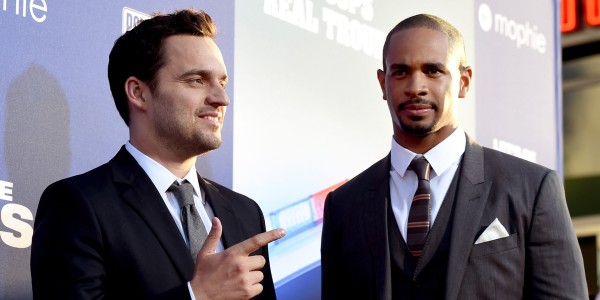"Lord of the Rings" fans once lamented the twisted little fiend Gollum — created by a blend of human performance and digital effects — didn't get his due during Hollywood's awards season.
Years later, the combination of live-action performance overlaid with computer animation has hit a new peak with "Avatar" — an awards favorite this season, even though the performers beneath all that digital wizardry have gone overlooked for acting honors.
"Avatar" is tied for the lead at the Academy Awards with nine nominations, among them best picture, director for James Cameron, musical score and most of the technical categories.
The science-fiction sensation's stars — Zoe Saldana, Sam Worthington and Sigourney Weaver — drew solid praise, though not necessarily the sort of raves that would have hurled them into the thick of the Oscar acting race.
Yet the technology raises an is-it-live-or-is-it-Memorex question: Does the performance come from the actors or the animators?
‘Acting community needs to be educated’Nothing in the Oscar-voting rules prohibits these "performance-capture" roles — or even voice work — from earning acting nominations. Yet as lifelike as digitally assisted characters might look, there remains a sense in Hollywood they are more a result of technical innovation than acting talent.
Cameron and others suggest it might be a matter of enlightening the industry as to what's really involved in performance-capture roles — where actors perform on bare soundstages, with digital cameras and sensors capturing their body language and visual-effects artists later filling in costumes, features and other details.
"There's nothing to say that they would have been nominated had it been an even playing field and had there been performances photographed instead of captured," Cameron said. "But I do think that there is an issue here where the acting community needs to be educated about what it is performance-capture really is, especially the way we did it on 'Avatar,' where we preserved every nuance of the performance.
"And hopefully, if we could overcome that learning curve over the next couple years, then next time a performance-capture film comes along, that it will be an even playing field."
Worthington and Weaver appear in much of "Avatar" as their human selves, their performance-capture alter-egos coming in portions where the characters take on the form of the 10-foot-tall Na'vi, the dominant species on the distant moon Pandora.
Saldana plays a native Na'vi, her entire role delivered through performance-capture.
‘It is a performance’For Worthington, the work he did in his performance-capture scenes — wearing a skintight suit covered with sensor dots read by the digital cameras — was as much an acting job as his live-action sequences.
"It is a performance. It hasn't been animated on top of that. That to me was a big thing, that they don't enhance my performance in any way," Worthington said. "Whatever we did does translate exactly 100 percent. Maybe my nose is animated and my tail. That's because I don't have a tail. And the ears are a bit different, but those are about the only things they've changed."
Cameron even strapped tails and big ears on the actors playing the Na'vi so their performances would reflect the body language of creatures with those appendages, Worthington said.
Convincing more conventional actors such as Anthony Mackie of the worthiness of performance-capture could be a Na'vi-sized challenge, indeed.
"'Avatar' was good, but it wasn't a movie, it was a spectacle," said Mackie, who has a supporting role in "The Hurt Locker," "Avatar's" stiffest competition in this year's Oscar race. "I'm excited to see exactly how they reward the work we do."
Slideshow 26 photos
Celebrity Sightings
Some feel Hollywood's lack of recognition for performance-capture is a matter of inexperience.
"I really do think there is a prejudice among certainly many actors against these kind of performances — particularly from actors who have never done it before," said Entertainment Weekly film reporter Dave Karger, who covers Hollywood and the Oscars.
"Until people are educated about what goes into a performance-capture film, I don't think anyone will ever have a chance to get nominated from one."
Not a new issueThe debate over what might constitute an awards-worthy performance is not new. In 1992, Robin Williams earned Oscar buzz for his effervescent voice role in the animated adventure "Aladdin," though the chatter did not result in a nomination.
Andy Serkis won high praise for his work as Gollum in the last two "Lord of the Rings" films, his character created through motion-capture filming that was a precursor to the more-immersive technology Cameron used on "Avatar."
"Really, it's terrible that Gollum didn't win an award. He was brilliant. He's the main thing in the movie," said "Avatar" co-star Weaver, who earned a best-actress nomination for Cameron's "Aliens."
So far, there have been only a handful of films featuring substantive performances created this way, including Robert Zemeckis' "The Polar Express," "Beowulf" and "A Christmas Carol."
Zemeckis plans to keep working in performance-capture, and the runaway success of Cameron's "Avatar" makes sequels likely and may inspire other directors to try out the technology.
Sooner or later, the technology may produce an undeniably great performance that forces awards voters to consider it alongside searing live-action roles such as those delivered this season by Oscar front-runners Jeff Bridges in "Crazy Heart" or Mo'Nique in "Precious."
"A Christmas Carol" producers Steve Starkey and Jack Rapke borrow a line from Ray Winstone, who played the title role in their and Zemeckis' "Beowulf."
"What Ray Winstone said is the difference between this and live action is that in live action, you go into hair and makeup, you go into wardrobe, and then you act," Starkey said. "In this, you act, and then they put on your hair and makeup. There is no difference. You're acting in both, and I say it should be considered as a real performance."
